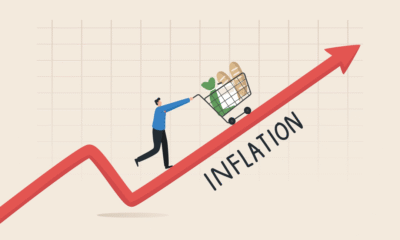Finance
Navigating Retirement in the Gig Economy: Challenges and Solutions

Understanding the Gig Economy
The gig economy refers to a labor market characterized by short-term contracts, freelance work, and flexible job arrangements as opposed to traditional, permanent employment. It encompasses various sectors, from technology and creative industries to transportation and hospitality. The rapid growth of the gig economy can be attributed to several factors, including technological advancements, changing workforce preferences, and evolving business models. In recent years, platforms such as Uber, Upwork, and TaskRabbit have transformed how individuals engage with work, allowing them to operate on a project-by-project basis.
The prevalence of gig work in today’s labor force is evident; recent studies suggest that nearly one-third of the U.S. workforce is involved in some form of gig employment. This demographic often includes millennials and Generation Z workers who prioritize flexibility and autonomy over conventional career paths. Additionally, many gig workers are seeking supplementary income to support their financial needs amidst rising living costs. The appeal of working in the gig economy extends to retirees, who may wish to ease into retirement while still engaging in fulfilling work. These varied motivations highlight the diverse nature of gig workers and the adaptability of this workforce in meeting their individual financial and personal goals.
In terms of the types of jobs available, gig work ranges from driving for rideshare companies to providing freelance graphic design, consulting, tutoring, or even short-term manual labor. This flexibility allows individuals to select opportunities that match their skills and interests. However, it is essential to acknowledge that while the gig economy offers numerous advantages, it also presents unique challenges, including inconsistent income, lack of employee benefits, and job security concerns, which require careful consideration for those navigating retirement planning in this evolving landscape.
Unique Characteristics of Gig Workers
The gig economy, characterized by short-term contracts and freelance work rather than permanent employment, has become a significant aspect of modern labor markets. One of the unique characteristics of gig workers is the variability of their income. Unlike traditional employees who receive a stable salary, gig workers often experience fluctuating earnings depending on demand and project availability. This income unpredictability can lead to financial instability, making budgeting and long-term financial planning a challenge for those within this workforce.
Additionally, gig workers typically lack traditional employer benefits such as health insurance, retirement plans, and paid time off. The absence of these benefits can create additional stress and uncertainty, as individuals must plan for their own health care and retirement savings. This reality necessitates that gig workers take a proactive approach to their financial security, often requiring them to invest in alternative insurance options or retirement plans, which can be more complex compared to conventional workplace benefits.
Another defining feature of gig workers is the high level of independence and flexibility that their work offers. Many individuals are drawn to gig employment for the ability to set their own schedules and work from various locations. This flexibility can greatly enhance work-life balance, allowing gig workers to pursue other interests, responsibilities, or side projects. However, this autonomy can also lead to isolation, as gig workers often miss out on the social interactions and camaraderie found in traditional workplaces.
Moreover, the psychological impacts of these characteristics can be significant. While some workers thrive in an independent environment, others may struggle with feelings of loneliness or uncertainty about their career prospects. It is crucial for gig workers to acknowledge the distinct lifestyle they lead and develop coping strategies that can help mitigate the challenges associated with their unique working conditions.
Retirement Planning Basics
Retirement planning is a critical aspect of financial security that requires careful consideration and proactive strategies. As individuals transition into retirement, especially within the gig economy, understanding the fundamentals of effective retirement planning is imperative. The primary goal is to accumulate sufficient resources to support oneself in the post-employment phase. One effective method to achieve financial independence during retirement is to engage in a disciplined savings and investment approach.
Among the most common retirement savings vehicles are the 401(k) and Individual Retirement Account (IRA). A 401(k) plan, usually offered by employers, allows employees to save a portion of their salary before taxes are deducted, often with an employer matching contributions. In contrast, an IRA provides individuals with a tax-advantaged way to save for retirement, albeit with some contribution limits. Understanding the differences and advantages of each option is essential for maximizing retirement savings.
Setting specific savings goals is another fundamental step in retirement planning. Individuals should assess their expected lifestyle needs in retirement, which will help determine how much they need to save. A common benchmark is to aim for enough retirement savings to replace 70% to 80% of one’s pre-retirement income. This can feel daunting, but starting early allows individuals to take advantage of compound interest. Over time, even small contributions can grow significantly, ultimately leading to financial stability in retirement.
Traditionally, full-time employees have adhered to structured retirement planning strategies that involve employer-sponsored plans and potentially pension benefits. However, those in the gig economy can adopt similar principles by establishing personal retirement accounts and understanding how to effectively utilize available savings options. This proactive approach paves the way for a secure financial future during retirement, regardless of employment status.
Challenges Faced by Gig Workers in Retirement Planning
The gig economy has introduced a new paradigm of work; however, it presents unique challenges for workers when it comes to retirement planning. One of the foremost challenges is the nature of inconsistent income. Gig workers often experience fluctuations in their earnings, which can make it difficult to establish a predictable retirement savings plan. Unlike traditional employees who receive a steady paycheck, gig workers may find themselves with varying income levels from month to month, complicating their ability to save effectively.
Another significant obstacle for gig workers is the absence of employer-sponsored retirement plans. Many traditional employment opportunities offer retirement benefits, such as 401(k) plans with matching contributions, which are rarely available to gig workers. This lack of formal benefits means that gig workers must take full responsibility for their retirement savings, necessitating a proactive approach to setting aside funds without the incentivization that comes from employer contributions.
Additionally, gig workers often struggle to establish long-term savings habits. The transient nature of gig work can lead to a focus on immediate expenses rather than long-term financial planning. This can result in a lack of urgency to create a dedicated retirement savings account, despite the potential need for future financial security. Furthermore, the challenge of accessing personalized financial advice tailored to their unique situations can hinder gig workers from making informed decisions about their retirement. Many financial advisors may not fully understand the nuances of gig work, leading to generic advice that fails to address their specific needs.
Overall, these challenges underscore the importance of increased awareness and resources designed explicitly for gig workers. Understanding these obstacles is a crucial step in navigating retirement planning effectively within the evolving landscape of the gig economy.
The Importance of Self-Directed Retirement Accounts
As the gig economy continues to expand, individuals engaged in freelance and contract work often find themselves without the traditional employer-sponsored retirement plans. For these gig workers, self-directed retirement accounts (SDRAs) can play a pivotal role in establishing a sustainable savings strategy. Among the various types of SDRAs available, the Solo 401(k) and the Simplified Employee Pension (SEP) IRA stand out as popular choices for self-employed individuals.
The Solo 401(k) is designed specifically for solo entrepreneurs and allows for significant contribution limits compared to other retirement plans. In 2023, individuals can contribute up to $22,500 as an employee contribution, with an additional catch-up contribution of $7,500 for those aged 50 and older. Furthermore, as the employer, gig workers can also contribute an additional 25% of their net earnings, which enhances the overall savings potential. This dual contribution option provides opportunities for substantial tax-deferred growth over time, making it an attractive option for those looking to maximize their retirement funds.
On the other hand, the SEP IRA also offers flexibility and ease of administration, making it another excellent choice for gig workers. Contributions to a SEP IRA can be as high as 25% of an individual’s net earnings, with a maximum limit of $66,000 for 2023. This plan allows for varying contribution amounts each year, which is particularly beneficial for gig workers whose incomes can fluctuate dramatically. The tax advantages of both plans can significantly reduce taxable income, thereby allowing gig workers to retain more capital for their retirement savings.
Real-life examples further illustrate the advantages of SDRAs. For instance, a freelance graphic designer utilizing a Solo 401(k) can contribute a substantial amount during lucrative months, creating a buffer for leaner periods. Similarly, a part-time consultant may benefit from a SEP IRA, adjusting contributions based on their varying income. These self-directed accounts empower gig workers to take control of their financial futures, ensuring they build a more secure retirement. With the right strategy, individuals can effectively navigate the complexities of retirement planning within the gig economy.
Creating a Custom Retirement Strategy for Gig Workers
As gig workers navigate the complexities of their unique employment landscape, forming a personalized retirement strategy becomes essential. Unlike traditional employees who often benefit from employer-sponsored retirement plans, gig workers must take the initiative to establish their own retirement savings. The first step in this process involves determining how much to save. A practical approach is to assess your current income variability and set aside a percentage of your earnings specifically for retirement. Financial experts often recommend aiming for a minimum of 15% of your income directed towards retirement savings, although individual circumstances will dictate the exact amount.
When it comes to selecting investment vehicles, gig workers should explore a range of options. Traditional Individual Retirement Accounts (IRAs) and Roth IRAs are popular choices that offer different tax advantages. A Solo 401(k) is another suitable option, particularly for those who earn substantial income from gig work, allowing for higher contribution limits. Each of these vehicles has unique benefits that align with different financial goals, so it is advisable to conduct thorough research or consult a financial advisor to determine the most suitable choice.
Setting both short-term and long-term financial goals is also crucial. It is beneficial to establish clear, actionable objectives to maintain motivation and provide direction. Short-term goals may include building an emergency fund or saving for a specific investment, while long-term goals often involve planning for eventual retirement needs. Regularly reviewing and adjusting these goals in response to income fluctuations, market changes, or personal circumstances will ensure the longevity and effectiveness of your retirement strategy. By thoughtfully crafting a custom retirement plan, gig workers can secure their financial future amidst the dynamic and often unpredictable nature of gig employment.
The Role of Financial Advisors for Gig Workers
In today’s evolving employment landscape, gig workers face unique financial challenges that require specialized planning, particularly concerning retirement. Financial advisors with expertise in the gig economy can play a pivotal role in assisting these workers to navigate the complexities of retirement planning. Unlike traditional employees, gig workers often lack access to employer-sponsored retirement plans, making it essential to seek professional guidance tailored to their specific needs.
When choosing a financial advisor, gig workers should look for professionals who demonstrate a deep understanding of the gig economy. This includes familiarity with variable income streams, tax implications of freelance work, and the importance of establishing an individual retirement strategy. An advisor should not only provide services like investment management and tax planning, but also help in crafting a personalized savings plan that accommodates fluctuating income and unpredictable work schedules.
Moreover, collaboration with a financial advisor can enhance retirement preparedness by implementing strategies designed for long-term financial health. Advisors can guide gig workers in setting up retirement accounts such as IRAs or solo 401(k)s, which can be beneficial for self-employed individuals. They can also assist in understanding and leveraging available tax deductions that are often overlooked by independent contractors, thus maximizing potential savings for retirement.
In addition to standard financial planning services, advisors can provide insights into diversifying income streams or transitioning into more stable forms of employment, should the worker desire a shift. As retirement approaches, a skilled financial advisor can help gig workers to evaluate their cumulative savings and adjust their investment strategies accordingly, ensuring that their retirement goals remain achievable despite the uncertainties inherent in gig work.
Building an Emergency Fund
For gig workers, who often experience fluctuations in income, establishing an emergency fund is not just a recommendation; it becomes a vital safety net. An emergency fund serves as a financial buffer to mitigate unexpected expenses such as medical emergencies, car repairs, or sudden income loss. With the uncertainty inherent in gig work, having an emergency fund can significantly ease financial stress, allowing workers to navigate challenges more effectively.
To begin building an emergency fund, gig workers should aim to set aside three to six months’ worth of living expenses. The exact amount can vary based on individual circumstances, including monthly expenses, dependents, and overall job stability. For those just starting, a target of $1,000 to $2,000 can provide an initial cushion. This fund should be easily accessible, ideally kept in a high-yield savings account or another financial vehicle that balances liquidity with the potential for earning interest.
Maintaining an emergency fund requires consistent effort and discipline. It can be beneficial to create a monthly savings plan where a small percentage of each paycheck is allocated to the fund. This can often be achieved through automating transfers on paydays to ensure that savings take precedence. Moreover, gig workers should regularly review their expenses and adjust their savings goals as income fluctuates. Assessing the fund at least semi-annually ensures that the amount remains adequate as living expenses and personal situations evolve.
Ultimately, having a well-prepared emergency fund can act as a stabilizing factor for gig workers, providing them with greater peace of mind. This financial foundation not only aids in managing short-term crises but also contributes to long-term planning, empowering gig workers to pursue their career paths with confidence.
Community Resources and Support for Gig Workers
The gig economy has transformed traditional employment structures, introducing both opportunities and challenges for workers. To navigate retirement effectively within this evolving landscape, various community resources are available to support gig workers in their financial planning and overall well-being. Numerous organizations and initiatives aim to empower these individuals through educational programs, networking opportunities, and tailored resources.
One significant area of support is the emergence of online platforms dedicated to financial literacy for gig workers. Websites such as Skillshare and Coursera offer workshops and courses focusing on financial management, retirement planning, and investment strategies specifically designed for freelancers and independent contractors. These accessible resources enable gig workers to gain essential knowledge that can aid in their long-term financial planning.
Additionally, local community centers and libraries often host workshops that cater specifically to gig workers. These workshops cover a range of topics, including budgeting, tax preparation, and retirement savings plans. Engaging with financial advisors who understand the unique circumstances of gig employment can provide invaluable insights into effective retirement strategies that are often overlooked in conventional employment frameworks.
Networking within the gig community is crucial for fostering knowledge and support among peers. Organizations such as the Freelancers Union engage in advocating for workers’ rights while offering benefits and resources aimed at enhancing the gig worker’s experience. Creating or joining local meetups, forums, or social media groups allows individuals to connect with others who share similar challenges, fostering an environment where experiences and best practices can be exchanged.
In conclusion, the gig economy presents unique challenges for retirement planning, but a wealth of resources exists to support workers in their journey. By taking advantage of these community resources, attending workshops, and engaging in networking opportunities, gig workers can enhance their understanding of retirement strategies, ensuring a more secure future.
Investing
Global Investor Outflows from U.S. Stocks & Dollar

In a shift that is sending ripples across financial markets, institutional investors around the world are pulling back from U.S. equities and reducing exposure to the U.S. dollar, signaling a significant change in sentiment toward American assets. According to the latest Bank of America Global Fund Manager Survey, global investors are now the most underweight on U.S. stocks in more than two decades, with the dollar facing similar skepticism as a long-term safe-haven asset. This transition is being fueled by multiple converging factors, including geopolitical instability, growing U.S. fiscal deficits, trade tensions, and an increasingly favorable investment climate in Europe and select emerging markets. For investors, economists, and policymakers alike, this trend represents a rebalancing of global capital flows that could reshape market dynamics in the months ahead.
Investor Sentiment Toward U.S. Markets Hits Multi-Year Lows
The Bank of America survey, considered a key barometer of global institutional sentiment, reveals that fund managers have turned heavily underweight on U.S. stocks and the dollar, preferring instead to rotate their portfolios into European and Asian equities. The survey showed that 36% of participants are now net underweight U.S. equities—the highest level since 2003. At the same time, positioning on the dollar turned net negative for the first time in over five years, with investors citing mounting fiscal concerns, valuation extremes, and weakening macroeconomic indicators.
The U.S. equity market, especially the tech-heavy NASDAQ, has experienced an extraordinary bull run over the last several years. But now, investors are questioning the sustainability of elevated valuations, particularly as economic growth slows, earnings forecasts are revised downward, and inflation remains persistently above target. Many portfolio managers believe the best returns may no longer be found in U.S. assets alone.
Rising U.S. Debt and Fiscal Deficits Raise Red Flags
A key driver of investor caution is the ballooning U.S. fiscal deficit. The Congressional Budget Office (CBO) projects that the U.S. federal deficit will reach over $1.8 trillion this year, driven by increased government spending, rising interest costs, and lower-than-expected tax revenues. The national debt is now projected to exceed 125% of GDP by 2030, raising serious questions about long-term fiscal sustainability.
Investors fear that soaring U.S. debt levels could lead to a loss of confidence in Treasury securities, pushing yields higher and triggering volatility in global credit markets. This concern is magnified by the growing political polarization in Washington, which has led to repeated debt ceiling standoffs and policy gridlock. As a result, some asset managers are choosing to diversify their bond portfolios with sovereign debt from countries like Germany, Canada, and Australia—nations viewed as having stronger fiscal discipline.
Geopolitical Tensions Erode Dollar Safe-Haven Appeal
The traditional role of the U.S. dollar as a global safe-haven currency is also being called into question. With the U.S. now embroiled in rising geopolitical conflicts, including its military engagement in the Middle East and an escalating trade war with China, the perception of the dollar as a “neutral” or stable currency is beginning to fade. Several countries, particularly in the Global South, have voiced frustration over the dominance of the dollar in international trade, and some have even accelerated efforts to settle trade in alternative currencies such as the euro, yuan, or local currency blocs.
In response, central banks in emerging markets are reducing their U.S. dollar reserves and increasing holdings in gold and non-dollar currencies. This trend, while gradual, is gaining momentum and contributing to the dollar’s underperformance against a basket of global currencies. The U.S. dollar index (DXY) has declined by nearly 6% year-to-date, reflecting both diminished investor confidence and a broader reconfiguration of reserve management strategies.
Attractive Valuations Abroad Drive Capital Outflows
While risks in the U.S. are mounting, attractive investment opportunities abroad are also contributing to the outflow of capital from American markets. European equities, particularly in sectors like green energy, luxury goods, and financial services, are seeing renewed interest thanks to relatively low valuations and improving macroeconomic stability. The recent ECB rate cuts and Eurobond discussions have added to optimism about the region’s fiscal and financial integration.
In Asia, countries like India, Indonesia, and Vietnam are emerging as new hotspots for foreign direct investment and equity inflows. These economies offer robust growth prospects, younger demographics, and increasingly tech-driven industries. Additionally, Japan’s bond market is seeing increased institutional buying, as long-term yields rise in response to the Bank of Japan’s policy changes.
This global diversification strategy is not just about seeking higher returns—it’s also about managing risk. Investors are increasingly looking to balance their portfolios geographically, reducing dependence on any single region and hedging against macroeconomic shocks that may be specific to the U.S.
Currency Hedging and Diversification as Defensive Strategies
In response to the dollar’s volatility, many fund managers are now engaging in currency hedging strategies to protect their portfolios. Currency ETFs, options, and forward contracts are being used to minimize the downside risk of a weakening dollar. At the same time, global investment funds are ramping up their exposure to non-dollar-denominated assets, including eurozone corporate bonds, emerging market debt, and local-currency sovereign issues.
Moreover, ESG and green bond markets in Europe and Asia are attracting capital due to their alignment with global sustainability goals. These instruments not only offer diversification but also align with broader institutional mandates on responsible investing.
Implications for U.S. Markets and Monetary Policy
The capital flight from U.S. assets could have significant implications for American markets. A persistent decline in foreign demand for U.S. Treasuries may force the Federal Reserve to intervene more frequently in the bond market to maintain liquidity and control yields. At the same time, a weaker dollar could contribute to imported inflation, complicating the Fed’s efforts to bring core inflation back within its target range.
On the equities side, if investor outflows persist, U.S. companies may face higher capital costs and declining valuations, particularly in sectors that rely heavily on foreign investment or exports. Domestic pension funds and institutional investors may need to fill the gap left by global investors, which could further alter asset allocation strategies and influence corporate financing decisions.
A New Era of Global Capital Rotation
The growing shift away from U.S. stocks and the dollar signals the beginning of a new era in global investing, one defined by diversification, geopolitical hedging, and currency rebalancing. While the U.S. remains a central player in global finance, the days of unquestioned dominance are beginning to fade, as investors embrace a more nuanced and distributed view of risk and opportunity.
For market participants, staying agile in this environment means tracking global fund flows, monitoring geopolitical developments, and reassessing the traditional U.S.-centric portfolio model. As capital continues to flow into European and Asian markets, the future of global finance is being rewritten—and those who adapt early may find themselves ahead of the curve.
Finance and Economy
France Pushes Eurozone Toward Joint Eurobond Issuance

In a bold move that could redefine the financial architecture of the European Union, France has renewed its push for the issuance of joint eurozone debt instruments – commonly referred to as Eurobonds – as a way to strengthen the euro on the global stage. As the EU prepares for its upcoming summit on June 26-27, the proposal is once again stirring heated debate among member nations. French officials argue that a shared debt mechanism is essential not only for financial resilience but also for elevating the euro’s standing as a credible alternative to the U.S. dollar. While the idea garners support from key institutions like the IMF and the ECB, resistance from fiscally conservative member states continues to block consensus. This article explores the implications of France’s proposal, the potential benefits and challenges of Eurobond issuance, and the evolving role of the euro in a multipolar financial world.
France’s Strategic Case for Eurobonds
French President Emmanuel Macron and Finance Minister Bruno Le Maire have long been advocates for deeper EU financial integration. According to them, Eurobonds would represent a tangible step toward fiscal solidarity and monetary cohesion, allowing member nations to borrow at collectively favorable rates while demonstrating political unity. The latest push comes at a time when the European economy is facing several headwinds: slowing growth, fragmented recovery across member states, and heightened global financial volatility triggered by geopolitical conflicts and energy insecurity. Macron has reiterated that a common debt tool is essential for financing major EU-wide projects such as green energy transition, digital infrastructure, and military defense.
From a strategic standpoint, France views Eurobonds as more than just a financial mechanism – they are a symbol of EU credibility and resilience. By pooling risk and aligning borrowing capacity, the eurozone could present a united front in capital markets, reducing the vulnerability of weaker economies and improving the euro’s attractiveness to foreign investors.
The Euro’s Current Global Standing and Its Challenges
Despite being the world’s second most-used currency, the euro still lags far behind the U.S. dollar in terms of global reserve share, trade settlement, and safe-haven preference. Analysts point out that one of the primary reasons for this is the fragmented nature of the eurozone bond market. Each country issues its own sovereign debt, leading to a lack of a single, risk-free eurozone bond benchmark – unlike U.S. Treasuries, which offer deep liquidity and low risk.
France’s proposal seeks to address this imbalance. A unified Eurobond market could create a highly liquid, stable, and scalable financial product that would attract central banks, pension funds, and sovereign wealth investors. Over time, this could shift more global reserves into euros, boosting the currency’s influence in global trade and finance.
Institutional Support: IMF, ECB, and Market Participants
Key international organizations have thrown their weight behind the idea. The International Monetary Fund (IMF) has suggested that Eurobonds could enhance the EU’s fiscal capacity and crisis response agility. Meanwhile, European Central Bank (ECB) officials, including President Christine Lagarde, have hinted that deeper fiscal integration is necessary for the euro to realize its full potential.
Financial market participants have also shown interest. Asset managers argue that Eurobonds could become a cornerstone of fixed-income portfolios, particularly for investors looking to diversify away from dollar-denominated assets. Some analysts compare the opportunity to the creation of the U.S. Treasury market in the post-war era, which laid the groundwork for the dollar’s global dominance.
Opposition from the Frugal Four and Risk-Sharing Concerns
Despite France’s enthusiasm and institutional support, significant opposition persists from fiscally conservative EU nations, notably Germany, Austria, the Netherlands, and Finland—often dubbed the “Frugal Four.” These countries argue that shared debt would penalize responsible fiscal behavior and open the door to moral hazard, where weaker economies might overborrow under the protection of joint guarantees.
German officials have also cited constitutional constraints and public opposition to any perceived “debt mutualization.” Instead, they advocate for reforms at the national level, more stringent budget controls, and the use of existing mechanisms like the European Stability Mechanism (ESM) for crisis funding.
This divide continues to stall formal negotiations. At the heart of the debate is the question of trust and fiscal governance, as many northern states remain skeptical about the long-term commitment of their southern counterparts to austerity and budget discipline.
Implications for Financial Markets and Investors
If approved, Eurobonds would be a game-changer for European capital markets. They would offer a new safe asset class, potentially rivaling U.S. Treasuries in size and reliability over the long term. For the European banking system, Eurobonds could provide high-quality collateral and improve liquidity conditions, especially for cross-border lending.
Investors are closely monitoring the situation. If the EU takes concrete steps toward joint bond issuance, bond yields across peripheral economies like Italy, Spain, and Greece could compress further, as risk premia shrink in anticipation of shared guarantees. Simultaneously, euro-denominated assets may see a surge in foreign inflows, especially from central banks seeking to rebalance reserve portfolios.
Strengthening the Euro’s Role in a Multipolar World
The geopolitical landscape is increasingly defined by multipolarity, with China, Russia, and the U.S. competing for influence in trade, finance, and security. In this context, the eurozone faces a historic opportunity to carve out a more assertive role. Strengthening the euro through fiscal and capital market integration is seen as essential to counterbalance the dollar’s dominance and reduce reliance on U.S.-led financial infrastructure.
Eurobonds could serve as a financial pillar in this transition. As global investors seek alternatives in a fragmented world economy, the euro’s rise as a stable, investable, and liquid currency backed by joint instruments could bolster its credibility and utility.
A Defining Moment for European Unity
France’s push for Eurobonds is more than just a fiscal proposal – it is a call for political and financial unity in a time of global uncertainty. While the road to consensus is steep, the growing support from institutions, investors, and southern EU members suggests that momentum is building. The upcoming EU summit will be a crucial test of the bloc’s ability to move beyond national interests and toward a shared financial future.
If successful, Eurobond issuance could redefine the eurozone’s role in the global economy, offering new tools for crisis response, economic development, and financial competitiveness. For investors and policymakers alike, this moment marks a critical juncture – either Europe seizes the opportunity to lead, or it risks remaining a secondary player in a rapidly evolving financial world.
Finance and Economy
Oil Price Spike as Middle East Conflict Deepens: A Global Market Wake-Up Call

The financial world is once again on high alert as escalating tensions in the Middle East have triggered a sharp surge in global oil prices, sending shockwaves through equity, commodity, and currency markets alike. With the U.S. reportedly striking Iran’s nuclear sites, Brent crude surged over 18%, nearing $80 per barrel in a matter of hours. The sudden volatility reignited fears of a potential $100 oil scenario, reminiscent of past geopolitical flashpoints that deeply impacted global supply chains, inflation expectations, and central bank policy stances. This article delves into the causes, consequences, and global financial implications of this emerging crisis.
The Trigger: U.S. Strikes on Iran’s Nuclear Infrastructure
On June 21, 2025, international news outlets confirmed that U.S. military forces had targeted Iranian nuclear facilities in what they described as a “pre-emptive defensive measure.” While the full extent of the damage is still being assessed, the attack has clearly escalated tensions in an already volatile region. The Middle East, being a vital hub for global oil production and shipping, plays a significant role in maintaining supply stability. Iran, which controls access to the Strait of Hormuz – a key chokepoint through which nearly 20% of the world’s oil supply passes—responded with threats to close the strait and intensify its military posturing. This heightened the risk premium in energy markets virtually overnight.
Oil Prices React Swiftly to Geopolitical Instability
Crude oil, especially Brent and West Texas Intermediate (WTI), reacted with extreme sensitivity to the developments. Brent crude jumped over 18% within a 24-hour period, while WTI saw a comparable surge. Analysts at Goldman Sachs and JPMorgan warned that if the Strait of Hormuz were to be blocked, prices could surpass $100 per barrel within weeks. The last time the oil market saw such an intense geopolitical premium was during the 2019 drone attacks on Saudi oil facilities. However, the current situation has a more severe undertone due to the involvement of nuclear assets and direct military strikes between two powerful adversaries.
Safe Haven Assets Soar as Risk Appetite Declines
As is common in times of geopolitical crisis, investors flocked to safe-haven assets such as gold, the U.S. dollar, and U.S. Treasuries. Gold climbed above $2,400 per ounce, a level not seen in years, while the U.S. dollar index rose nearly 2% as capital fled emerging markets and riskier assets. Meanwhile, 10-year U.S. Treasury yields fell sharply, reflecting a surge in demand for perceived low-risk instruments. Cryptocurrency markets, particularly Bitcoin, experienced a brief rally as some investors viewed digital assets as alternative stores of value, although that rally quickly reversed amid broader market instability.
Stock Markets Face Broad Sell-Off, Led by Energy-Sensitive Sectors
Equity markets around the globe responded negatively. The S&P 500 and NASDAQ both dropped over 2.5% in intraday trading, led by declines in consumer discretionary, industrials, and airline stocks, which are highly sensitive to fuel price increases. European indices such as the FTSE 100 and DAX also saw steep losses, while Asia-Pacific markets like the Nikkei 225 and Hang Seng Index fell sharply as investors priced in a higher global risk premium. Interestingly, energy stocks provided the only bright spot in an otherwise red sea of market activity, with companies like ExxonMobil and Chevron posting strong gains on expectations of rising revenues.
Inflationary Pressures Could Derail Central Bank Strategies
The surge in oil prices couldn’t have come at a worse time for global central banks. After years of battling inflation through aggressive interest rate hikes, many central banks had only just begun to pause or consider rate cuts in 2025. However, higher energy prices feed directly into inflation, particularly in transport, manufacturing, and agriculture sectors, potentially forcing monetary authorities to reverse their dovish pivot. The European Central Bank (ECB), which had recently initiated its first rate cut in years, may now face pressure to hold off on further easing. Similarly, the Federal Reserve, which had opted to maintain its current rate in the last FOMC meeting, is likely to adopt a more hawkish tone moving forward.
Emerging Markets Bear the Brunt of the Crisis
The fallout from spiking oil prices is especially damaging for emerging markets, which are typically more sensitive to commodity price fluctuations. Countries like India, Turkey, and South Africa, which are major oil importers and have significant current account deficits, saw their currencies depreciate against the dollar. This adds to inflationary pressures and increases the cost of dollar-denominated debt, complicating fiscal and monetary policy responses. Foreign institutional investors also withdrew capital from these markets, adding to equity market stress and further depressing sentiment.
Global Economic Growth at Risk
Economists are revising down global GDP forecasts amid fears that higher oil prices will dampen consumer spending, elevate production costs, and destabilize corporate earnings. According to the IMF, a sustained oil price above $90 could reduce global GDP growth by 0.5% annually, with some regions like Southeast Asia and Sub-Saharan Africa experiencing even greater negative impacts. Supply chains, already recovering from post-pandemic disruptions and trade tensions, now face renewed uncertainty due to potential shipping bottlenecks in the Persian Gulf.
Outlook: What Comes Next for Markets and Policymakers?
Going forward, much depends on how the situation in the Middle East evolves. A de-escalation through diplomatic channels, possibly via UN or EU mediation, could stabilize oil prices and soothe market nerves. On the other hand, if Iran follows through on its threat to block the Strait of Hormuz or retaliates militarily, the crisis could escalate into a full-blown regional conflict with severe repercussions for global trade and energy supply. Policymakers worldwide are monitoring the situation closely, and emergency meetings by OPEC and G20 finance ministers are already being planned. The International Energy Agency (IEA) has also signaled its willingness to release strategic petroleum reserves if needed to calm markets.
The Road Ahead is Uncertain but Manageable
In the face of rising geopolitical tensions and economic uncertainty, investors are advised to adopt a cautious, diversified approach. While markets remain volatile and unpredictable, sound investment principles – such as maintaining a balanced portfolio, avoiding over-leveraged positions, and focusing on long-term fundamentals – remain more relevant than ever. The oil price spike triggered by the U.S.-Iran conflict is a potent reminder of how global politics and finance are deeply intertwined, and why staying informed and agile is critical in today’s interconnected world.
-

 Finance & Investment6 months ago
Finance & Investment6 months agoEmerging Markets to Watch in 2025: Opportunities and Risks
-

 Technology and Finance8 months ago
Technology and Finance8 months agoThe Future of Quantum Computing in Financial Modeling and Trading
-

 Finance7 months ago
Finance7 months agoUSA Market Trends & Global Finance Insights
-

 Finance8 months ago
Finance8 months agoNavigating Personal Finance in the Age of Inflation and High Interest Rates
-

 Economics6 months ago
Economics6 months agoGlobal Markets React to U.S. GDP Contraction: A Comprehensive Analysis
-

 Investing & Finance8 months ago
Investing & Finance8 months agoFractional Investing: The Path to Wealth Democratization
-

 Finance7 months ago
Finance7 months agoTop 10 High-Yield Savings Accounts in the US (2025 Edition)
-

 Finance8 months ago
Finance8 months agoDecentralized Finance (DeFi): Opportunity or Risk? A Deep Dive into the Rise of DeFi Platforms and Their Challenge to Traditional Finance



